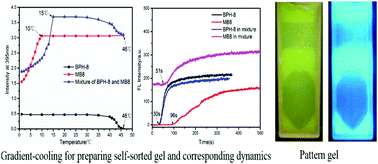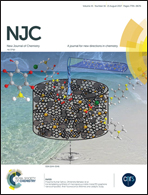Gelation behaviour and gel properties of two-component organogels containing a photoresponsive gelator†
Abstract
Herein, we report the gelation behaviour and gel properties of two-component organogels consisting of 1,4-bis[(3,4-bisoctyloxyphenyl) hydrozide] phenylene (BPH-8) and a photoresponsive gelator 4-[3,5-(bisoctyloxyphenyl)]-9-anthracene formyl hydrazine (MB8). It was demonstrated that the mixture of BPH-8 and MB8 showed self-sorted aggregation behaviour in ethanol. A gradient cooling procedure was used to obtain self-sorted gels of BPH-8 and MB8. Kinetics of gelation of the two component gels showed that Df values of MB8 fibers decreased due to the presence of BPH-8 gel. The two-component gels showed visible light (λvisible light = 350–570 nm) induced gel–gel transitions due to the orthogonal self-assembly of two gelators through the trans–cis conformation transition of –C![[double bond, length as m-dash]](https://www.rsc.org/images/entities/char_e001.gif) N– bond of MB8 component. In addition, the stable patterned two-component gel was achieved using a special shape mask, which enabled the gels to be irradiated by visible light in a particular area. The irradiated gels showed weak emission, reduced storage modulus, a shorter linear viscoelastic region, and higher wetting angle compared to that unirradiated region due to the collapse of the MB8 aggregates under visible light.
N– bond of MB8 component. In addition, the stable patterned two-component gel was achieved using a special shape mask, which enabled the gels to be irradiated by visible light in a particular area. The irradiated gels showed weak emission, reduced storage modulus, a shorter linear viscoelastic region, and higher wetting angle compared to that unirradiated region due to the collapse of the MB8 aggregates under visible light.



 Please wait while we load your content...
Please wait while we load your content...